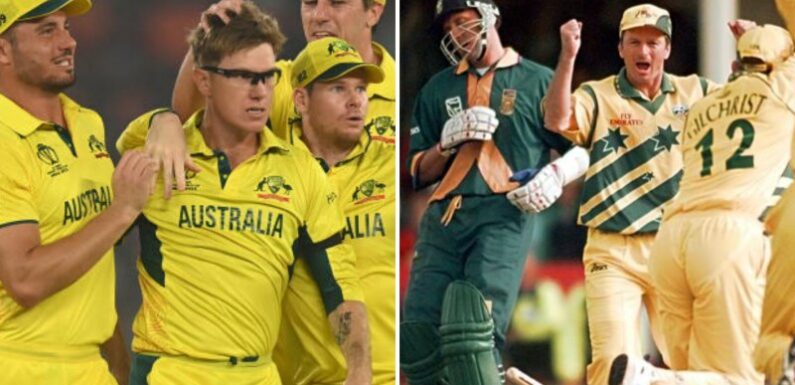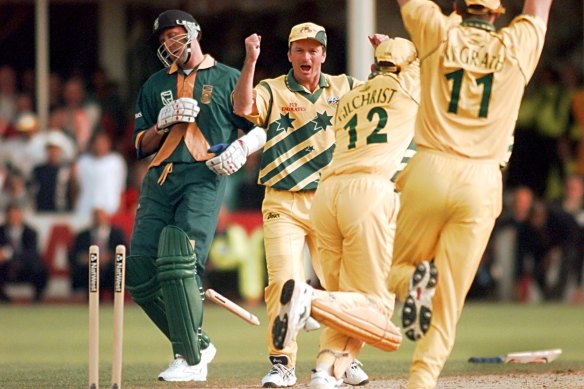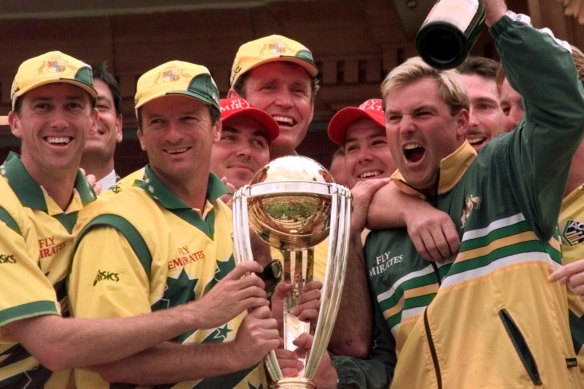
Save articles for later
Add articles to your saved list and come back to them any time.
“Donald didn’t run, I cannot believe it.”
It’s been 24 years since Bill Lawry lost his marbles in commentary and Allan Donald did likewise in the middle of Birmingham’s Edgbaston cricket ground.
Agony and ecstasy: Australia’s celebrations in 1999, along with Allan Donald’s despair, endure to this day.Credit: AP
Arguably the greatest one-day international ever played – with all its jubilation, joy, wretchedness and despair – remains perhaps the single most enduring World Cup image not just for Australia or South Africa, but the tournament itself.
And while most of those who’ll play in Thursday’s semi-final between the same two teams are now at an age where that tied match is, at best, among their earliest cricketing memories, the Edgbaston epic of 1999 still informs any Australian-South African clash.
Not least because it’s always fun, yet rarely wise to compare sporting eras, and in 2023 there are parallels to wallow in alongside our nostalgia.
A slow start to the Last Dance
After underwhelming losses to India and South Africa to begin Australia’s 2023 campaign, comparisons to ’99 were nigh unavoidable.
Just as Steve Waugh’s side was humbled by New Zealand and Pakistan on the small English grounds all those years ago, Pat Cummins’ men floundered in tricky conditions to start this tournament.
In ’99 it left the team famously needing to win every game (with a tie and a superior net run-rate ending up being enough) to keep their campaign alive. In years since, in-camp discussions of Steve Waugh being replaced as captain have emerged.
Cummins’ post hasn’t been spoken of in such terms, but the must-win stakes have, and Australia has won their past seven straight.
For David Warner (aged 36), Steve Smith, Glenn Maxwell, Marcus Stoinis (all 34) and Mitchell Starc (33) this is surely their last World Cup, while six other squad members are on the wrong side of 30.
While Waugh stared down his captaincy mortality during the 1999 tournament, Shane Warne famously told his teammates the night before “this might be the last game for a few of us”. Which dovetails nicely into…
Come in spinner
There’s only one Warnie and no one deserves comparisons to him. But Adam Zampa is blonde, wears an earring and is, along with India seam bowler Mohammed Shami, the most influential bowler of the tournament.
One more wicket will equal Muttiah Muralitharan’s 23 (at an average of 15.26) in 2007 as the most scalps ever claimed by a spinner in a World Cup.
Zampa’s economy rate (5.26 an over) has been imperious and punctuated by critical middle-over wickets. Australia probably wouldn’t be in the finals without him.
From chokers to comeback specials
Meanwhile, forgotten in the fervour of Damien Fleming’s famous final over in 1999 at Edgbaston, is that had South Africa eked out that pivotal final run, Australia would have shouldered a thoroughly justified World Cup chokers tag for another four years.
Pre-tournament favouritism became an unmitigated disaster on home soil in 1992. In 1996, they were humbled by Sri Lanka in dewy conditions having not trained under lights before the final.
When Lance Klusener blasted two boundaries in as many balls from Fleming’s first two offerings, one of sport’s most loathed tags loomed large.
That tag now definitely belongs to South Africa. As well as two instances (1992 and 2003) of the team crashing out thanks to the Duckworth-Lewis system, which recalculates targets in rain-affected matches, a series of great innings and batting collapses have added more pain over the years. There was Brian Lara in 1996, Donald forgetting how to run in ’99, batting collapses in 2007 and 2011 and New Zealand’s Grant Elliott starring in 2015.
The flip side is that Australia simply found a way to win – not unlike the back-to-back record ODI run chases of late featuring Glenn Maxwell doing Glenn Maxwell things.
Australia’s victorious 1999 World Cup squad.Credit: AP
‘What about that catch?’
Arguably Australia’s most dramatic upheaval throughout this current tournament has been not with bat or ball.
Correspondent Greg Baum succinctly summed up their woes after the heavy loss to South Africa with “fielding: what fielding?”
For further context, tournament stats provider Opta clocked Australia’s catching rate at 57 per cent from those two early losses.
Headlined by Marnus Labuschagne’s pyrotechnics against Bangladesh – which had the broadcasters throwing back to South African great Jonty Rhodes’ famous 1992 run-out of Inzaman Ul Haq for fun – Australia’s fielding has improved.
That catching rate is now at 83 per cent, and allows for a re-telling of one of Fleming’s favourite 1999 yarns.
Forever lost due to the result and Herschelle Gibbs’ immortal howler, is Paul Reiffel’s flailing fumble of a Lance Kluesener shot on the boundary when South Africa had one wicket left and 16 runs to get.
It went for six, but of course, Australia still won through to the final, where Queen Elizabeth II greeted Australian and Pakistan players before play at Lord’s.
Standing opposite Reiffel in the line-up, pugnacious Pakistan keeper Moin Khan pestered for the Victorian quick’s attention while Her Majesty approached.
“Oh! What about that catch?!” Moin sledged as he mimed Reiffel’s dropped catch, Fleming wrote in his biography.
The mind games didn’t work. Australia claimed the most emphatic win ever seen in a World Cup final.
Australian fans, particularly of a certain vintage, have luxuriated in that 1999 tournament ever since.
Given South Africa’s World Cup travails in the same period, they might just rank a mention this week too.
Sports news, results and expert commentary. Sign up for our Sport newsletter.
Most Viewed in Sport
From our partners
Source: Read Full Article

